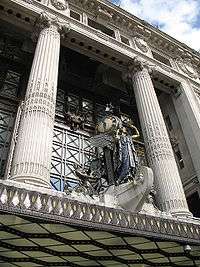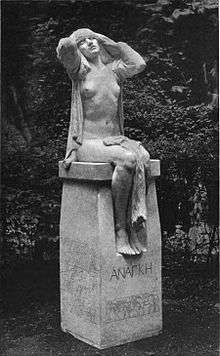Gilbert Bayes
Gilbert William Bayes (4 April 1872 – 10 July 1953) was an English sculptor.[1] Bayes art works varied in scale from medals to large architectural clocks, monuments and equestrian statues and he was also a designer of some note, creating chess pieces, mirrors and cabinets.[2]
Gilbert William Bayes | |
|---|---|
| Born | 4 April 1872 London, England |
| Died | 10 July 1953 (aged 81) Marylebone, London |
| Nationality | British |
| Education |
|
| Known for | Sculpture |
Career


Bayes was born in London into a family of artists, his father being Alfred Walter Bayes, an established artist at the time. He was one of four children and brother to both the well-known artist and critic Walter Bayes, and to the Arts & Crafts designer Jessie Bayes. Gilbert Bayes studied at the City and Guilds of London Art School and then at the Royal Academy Schools between 1896 and 1899, where he won a gold medal and a travelling scholarship to Paris.[3][2] Bayes' lengthy and illustrious career began as a student under Sir George Frampton and Harry Bates,[4] and so became associated with the British New Sculpture movement and its focus on architectural sculpture. He first exhibited at the Royal Academy in London from 1889 and later at the Paris Salon.[3] In Paris, Bayes won an honourable mention at the 1900 International Exhibition, then several medals at the Salon and, in 1925, a gold medal and diploma of honour at the Exhibition of Decorative Art.[5]
Bayes is perhaps best remembered for his interest in colour, his association with the Royal Doulton Company, and his work in polychrome ceramics and enamelled bronze. His 1939 major polychrome stonework frieze, Pottery through the Ages at the Doulton Headquarters in London was removed in the 1960s when the building was razed, and re-located to the Victoria and Albert Museum.[2][6] He also designed a number of war memorials, with public works throughout the former British Empire, from New South Wales to Bangalore.
Bayes served as President of the Royal British Society of Sculptors, PRBS, from 1939 through 1944, and of the Ealing Art Group from 1947–1953. He died in London in 1953.[3] Bayes' home at 4 Greville Place in St. John's Wood bears a blue plaque placed by English Heritage in 2007.[7]
Personal life
In 1906, Bayes married Gertrude Smith, a fellow sculptor, in Farnham, Surrey. They had two children:
- Eleanor Jean Gilbert Bayes (1908–1999), also an artist
- Geoffrey Gilbert Bayes (1912–2001)
Works
- Exterior work at the Victoria and Albert Museum under Sir Aston Webb, London, circa 1909[6]
- Prehistoric Period and Classic Period, architectural sculpture at the National Museum Cardiff, 1914–1915[8]
- Destiny, Albion Gardens, Ramsgate, Kent, dedicated 1920
- Hythe war memorial, Kent, 1921[9]
- Todmorden War Memorial, West Yorkshire, 1921
- The Offerings of Peace and The Offerings of War at the Art Gallery of New South Wales, 1923[10][2]
- The National War Memorial, St. John's, Newfoundland and Labrador, 1924. The bronze figures for the memorial were cast by Ercole James Parlanti of London.[11]
- The Building of King Solomon's Temple, "Central Warwickshire Masonic Temple" (demolished), Birmingham, 1927 (frieze in store)
- The Queen of Time bronze group above the Oxford Street entrance to London Selfridges, 1928[5]
- Drama Through the Ages, polychrome ceramic frieze for the Saville Theatre (now the Odeon Covent Garden cinema), London, 1931
- The Segrave Trophy, 1932[12][13][5]
- About 200 sculpted figures executed in coloured and glazed Doultonware set on washing line posts and finials in the housing estates of the St Pancras Home Improvement Society (later St Pancras Housing Assn) in Somers Town, London,and at York Rise Estate, Camden, 1920s and 1930s.[14]
- Exterior bas-reliefs and interior work at the BBC Broadcasting House, London, 1931[15]
- Six allegorical relief panels, Commercial Bank of Scotland, Bothwell Street, Glasgow, 1934–35
- A series of sporting figures outside Lord's cricket ground, 1934[1]
- Pottery through the Ages, polychrome ceramic frieze for the London headquarters of the Royal Doulton Company, 1939[2][6]
- Two memorial bronzes at the St James' Church, Warter
- Statue of Jamsetji Tata at the Indian Institute of Science, Bangalore
- Blue Robed Bambino fountain at the Centre William Rappard, Geneva (also known as Child with Fish)
- Reliefs featuring musicians on a building in Cavendish Square, London. The house had been the showroom of Brinmeads, the English piano manufacturer.
References
- Ian Chilvers (2004). The Oxford Dictionary of Art. Oxford University Press. ISBN 0 19 860476 9.
- University of Glasgow History of Art / HATII (2011). "Gilbert William Bayes HRI, PRBS". Mapping the Practice and Profession of Sculpture in Britain & Ireland 1851–1951. Retrieved 27 April 2020.
- Frances Spalding (1990). 20th Century Painters and Sculptors. Antique Collectors' Club. ISBN 1 85149 106 6.
- Public sculpture of Glasgow By Raymond McKenzie, Gary Nisbet
- David Buckman (2006). Artists in Britain Since 1945 Vol 1, A to L. Art Dictionaries Ltd. ISBN 0 953260 95 X.
- "Pottery through the Ages". Victoria and Albert Museum. Retrieved 27 April 2020.
- "BAYES, GILBERT (1931-1953)". English Heritage. Retrieved 20 October 2012.
- John Newman (1995). Glamorgan. The Buildings of Wales. London: Penguin. p. 228.CS1 maint: ref=harv (link)
- https://historicengland.org.uk/listing/the-list/list-entry/1430450
- AGNSW Catalogue references Offerings of Peace and Offerings of War
- "First World War Commemorations At Home". Newfoundland & Labrador in the First World War. Memorial University of Newfoundland. Retrieved 7 April 2020.
- "SEGRAVE TROPHY". The Sydney Morning Herald (29, 477). 25 June 1932. p. 9. Retrieved 14 December 2017 – via National Library of Australia.
- "SPIRIT OF ADVENTURE". The Mercury. CXXXVI (20, 222). Tasmania. 1 June 1932. p. 3. Retrieved 14 December 2017 – via National Library of Australia.
- Roland Jeffery, Housing Happenings in Somers Town in Housing the Twentieth Century Nation, Twentieth Century Architecture No 9, 2008, ISBN 978-0-9556687-0-8
- BBC Broadcasting House reliefs
External links
| Wikimedia Commons has media related to Gilbert Bayes. |